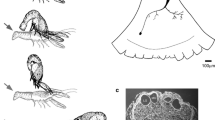Conclusions
-
1.
By the use of the classical motor-defensive method of conditioning to “pure time” in experiments onHelix lucorum changes can be detected in the responses of the pneumostome taking place during formation of the reflex.
-
2.
The newly formed reflex is conditioned with respect to its basic properties.
-
3.
The similarity of the properties of the conditioned pneumostome reflex formed inHelix lucorum and the conditioned reflex to “pure time” in higher animals suggests a similarity of the neurophysiological mechanisms of formation of the reflex.
-
4.
The results indicate the important role played by constantly acting factors of the experimental situation in the process of formation of a conditioned reflex to “pure time” in the snail.
Similar content being viewed by others
Literature cited
É. A. Asratyan, Lectures on Some Problems in Neurophysiology [in Russian], Izd. Akad. Nauk SSSR, Moscow (1959).
É. A. Asratyan, Essays on the Physiology of Conditioned Reflexes [in Russian], Nauka, Moscow (1970).
P. M. Balaban and E. G. Litvinov, Zh. Vyssh. Nerv. Deyat.,27, No. 3, 538 (1977).
B. I. Bayandurov, in: Conditioned Reflexes in Birds [in Russian], Krasnoe Znamya, Tomsk (1937), p. 28.
O. P. Bolotina, Trudy Irkutsk. Filial. Akad. Nauk SSSR, No. 1, 29 and 196 (1952).
L. G. Voronin, Comparative Physiology of Higher Nervous Activity [in Russian], Moscow Univ. Press, Moscow (1957).
V. S. Deryabin, “Further data on the physiology of time as a conditioned stimulus for the salivary gland,” Doctoral Disseration, St. Petersburg (1912).
A. S. Dmitriev, Zh. Vyssh. Nerv. Deyat.,13, No. 4, 704 (1963).
A. S. Dmitriev, in: The Physiological Mechanisms of Perception and Evaluation of Time [in Russian], Ufa (1968), p. 26.
G. P. Zelenyi, “Data on the response of dogs to acoustic stimuli,” Doctoral Dissertation, St. Petersburg (1907).
A. A. Krauklis, The Conditioned Reflex Regulation of Nervous Activity [in Russian], Izd. AN Latv. SSR, Riga (1960).
K. N. Krzhishkovskii, in: Transactions of the Society of Russian Physicians in St. Petersburg [in Russian], St. Petersburg (1908), Vol. 76.
E. G. Litvinov, O. A. Maksimova, P. M. Balaban, and B. P. Masinovskii, Zh. Vyssh. Nerv. Deyat.,26, No. 1, 203 (1976).
E. G. Litvinov and D. B. Logunov, in: Technical Problems and Equipment in Experimental Physiology [in Russian], Nauka, Moscow (1976), p. 94.
M. M. Nikiforovskii, Russk. Fiziol. Zh.,12, No. 5, 483 (1929).
I. P. Pavlov, Complete Collected Works [in Russian], Vol. 3, Book 2, Moscow-Leningrad (1951), p. 89.
M. M. Stukova, “Further data on the physiology of time as a conditioned stimulus for the salivary gland,” Doctoral Dissertation, St. Petersburg (1913).
Yu. P. Feokritova, “Time as a conditioned stimulus for the salivary gland,” Doctoral Dissertation, St. Petersburg (1912).
F. A. Brown, Jr., Am. J. Physiol.,178, 510 (1954).
I. Kupfermann, Physiol. Behav.,3, No. 1, 179 (1968).
Author information
Authors and Affiliations
Additional information
Translated from Zhurnal Vysshei Nervnoi Deyatel'nosti, Vol. 29, No. 4, pp. 784–792, July–August, 1979.
Rights and permissions
About this article
Cite this article
Logunov, D.B. Conditioned reflex to time inHelix lucorum . Neurosci Behav Physiol 11, 234–240 (1981). https://doi.org/10.1007/BF01184415
Received:
Issue Date:
DOI: https://doi.org/10.1007/BF01184415




